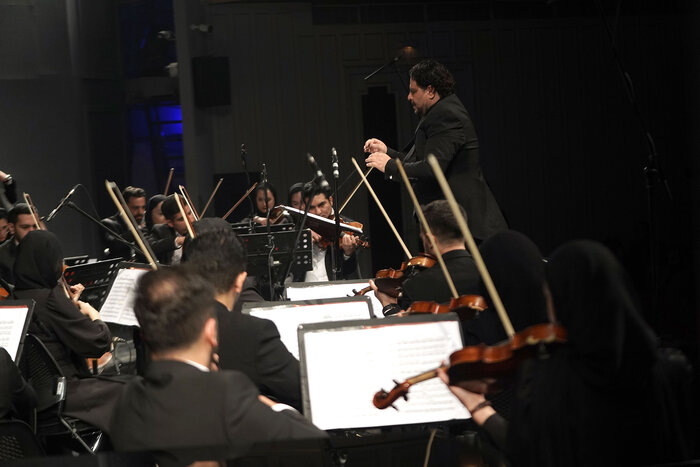
The 40th Fajr Music Festival kicked off with a performance by the IRIB Symphony Orchestra and Choir at Vahdat Hall. Despite featuring a diverse repertoire of classical and Iranian works, the concert faced challenges in coordination, sound quality, and execution.
On the evening of February 12, 2025, at 9:30 PM, Vahdat Hall hosted the opening night of the festival with a concert by the IRIB Symphony Orchestra and Choir. The performance was divided into two segments: the first focused on classical works, and the second on Iranian compositions.
In the first half, pieces from the global classical repertoire were performed, including Tchaikovsky’s Slavonic March, Brahms’ Hungarian Dances No. 1 and 5, excerpts from Fikret Amirov’s Azerbaijani Miniatures, parts of the Carmen Overture by Georges Bizet, and Leroy Anderson’s Plink Plank Plunk.
The second half featured works by prominent Iranian composers, beginning with Prayer to the Pure God by Heshmat Sanjari. This was followed by Rangarang by Rouhollah Khaleghi, Rhapsody for Tar and Orchestra by Fereydoun Shahbazian, and the theme music from the TV series Hezardastan by Morteza Hannaneh. Scent of Spring by Hassan Riahi brought a lyrical, melodic atmosphere to the stage. The program concluded with Ey Iran, another iconic piece by Khaleghi. The concert was conducted by Hossein Sharifi.
The performance opened with Tchaikovsky’s Slavonic March, but it was evident from the start that the string section lacked clarity and cohesion. Accents were not delivered with sufficient precision, and rhythmic issues were clearly noticeable throughout. In the woodwinds, the clarinet struggled with timing in its rapid passages, and several entries were out of sync. Additionally, major coordination problems affected the orchestral unity, leading to audible mishaps that disrupted the performance.
As the concert progressed, some of the rhythmic inconsistencies diminished, and the orchestra gradually became more cohesive. By the second half, overall coordination had improved. However, a recurring issue throughout the night was the unclear and unrefined sound of the strings, which significantly impacted the overall quality of the performance.
Brahms’ Hungarian Dances, known for their vivacious energy and expressive dynamism, require a lively and nuanced approach—especially from the string section. Yet, the strings lacked the necessary softness and flexibility in dynamics, failing to convey the grandeur and excitement inherent in the piece. The lack of dynamic variation and phrasing rendered the performance flat and emotionally distant.
Coordination problems persisted, as the various instrumental sections didn’t blend effectively. It often felt as though each group was playing independently rather than contributing to a cohesive whole. This lack of integration gave the orchestra a mechanical and lifeless quality, depriving the music of its natural flow and emotional depth. The energetic rhythms and dramatic shifts in the Brahms piece were not sufficiently emphasized, resulting in a performance that lacked the spirited vitality expected from such a work.
Sharifi conducted with his usual flair and animated gestures. Conductors often vary in style—some favoring restrained and minimalist movements, others employing grand, expressive motions. Ultimately, however, the effectiveness of a conductor is measured by the performance they elicit from the ensemble. In this case, particularly in the classical portion of the concert, Sharifi could have taken a more refined interpretative approach to achieve a clearer and more compelling orchestral sound. Despite his dramatic gestures, the orchestra occasionally lacked dynamic subtlety and musical depth. Furthermore, his energetic style did not prevent recurring rhythmic misalignments, highlighting that visual theatrics alone cannot ensure a cohesive and precise performance.
The orchestra then moved on to Azerbaijani Miniatures and excerpts from the Carmen Overture. The sound issues in the string section persisted, and the overall execution still lacked clarity and cohesion. In contrast, the wind section—especially the woodwinds—delivered a stronger performance. The interplay between oboe and flute in the call-and-response passages was one of the concert’s highlights, creating a charming and engaging atmosphere. The winds generally displayed better musical comprehension and ensemble unity, in stark contrast to the struggling strings.
Before the final piece of the first half, Sharifi addressed the audience, noting that “it’s not customary for a conductor to speak,” but he felt compelled to thank a mentor who transformed his musical path—Sir Heydarian. He also encouraged the audience to support the Tehran Symphony Orchestra’s upcoming concert under Heydarian’s baton.
The first half ended with a cheerful and lively piece featuring pizzicato strings and tambourine, creating a buoyant, rhythmic mood. The audience clapped along, responding warmly. However, the pizzicato passages suffered from poor coordination, which somewhat undermined the piece’s cohesiveness and clarity.
The second half began with the addition of the choir, led by Serjik Mirzaiyan. It opened with Prayer to the Pure God by Heshmat Sanjari. Overall, the orchestra performed the Iranian pieces with fewer flaws, showing more cohesion than in the first half.
Nonetheless, the choir struggled with timing and synchronization. Entry cues were frequently mistimed, and pair singing lacked coordination. Some singers began early, others late, compromising the overall unity. These issues were especially detrimental in works requiring precise collaboration between choir and orchestra, ultimately reducing the effectiveness of the performance.
In summary, this concert had the potential to be a compelling and diverse evening for orchestral music enthusiasts, with a well-chosen repertoire spanning both classical and Iranian genres. Despite the classical segment suffering from coordination and sound quality issues, the Iranian section was somewhat more polished. Although problems persisted with the choir and certain orchestral inconsistencies, the variety of the program and the effort to deliver a dynamic performance offered an engaging experience for fans of orchestral music.
Written By Farid Parish
